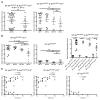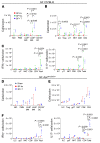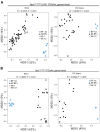Human colon mucosal biofilms from healthy or colon cancer hosts are carcinogenic
- PMID: 30855275
- PMCID: PMC6436866
- DOI: 10.1172/JCI124196
Human colon mucosal biofilms from healthy or colon cancer hosts are carcinogenic
Abstract
Mucus-invasive bacterial biofilms are identified on the colon mucosa of approximately 50% of colorectal cancer (CRC) patients and approximately 13% of healthy subjects. Here, we test the hypothesis that human colon biofilms comprise microbial communities that are carcinogenic in CRC mouse models. Homogenates of human biofilm-positive colon mucosa were prepared from tumor patients (tumor and paired normal tissues from surgical resections) or biofilm-positive biopsies from healthy individuals undergoing screening colonoscopy; homogenates of biofilm-negative colon biopsies from healthy individuals undergoing screening colonoscopy served as controls. After 12 weeks, biofilm-positive, but not biofilm-negative, human colon mucosal homogenates induced colon tumor formation in 3 mouse colon tumor models (germ-free ApcMinΔ850/+;Il10-/- or ApcMinΔ850/+ and specific pathogen-free ApcMinΔ716/+ mice). Remarkably, biofilm-positive communities from healthy colonoscopy biopsies induced colon inflammation and tumors similarly to biofilm-positive tumor tissues. By 1 week, biofilm-positive human tumor homogenates, but not healthy biopsies, displayed consistent bacterial mucus invasion and biofilm formation in mouse colons. 16S rRNA gene sequencing and RNA-Seq analyses identified compositional and functional microbiota differences between mice colonized with biofilm-positive and biofilm-negative communities. These results suggest human colon mucosal biofilms, whether from tumor hosts or healthy individuals undergoing screening colonoscopy, are carcinogenic in murine models of CRC.
Keywords: Bacterial infections; Colorectal cancer; Microbiology; Mouse models; Oncology.
Conflict of interest statement
Figures








Comment in
-
Gut microbial biofilm composition and organisation holds the key to CRC.Nat Rev Gastroenterol Hepatol. 2019 Jun;16(6):329-330. doi: 10.1038/s41575-019-0148-4. Nat Rev Gastroenterol Hepatol. 2019. PMID: 31040399 No abstract available.
References
Publication types
MeSH terms
Grants and funding
LinkOut - more resources
Full Text Sources
Other Literature Sources

